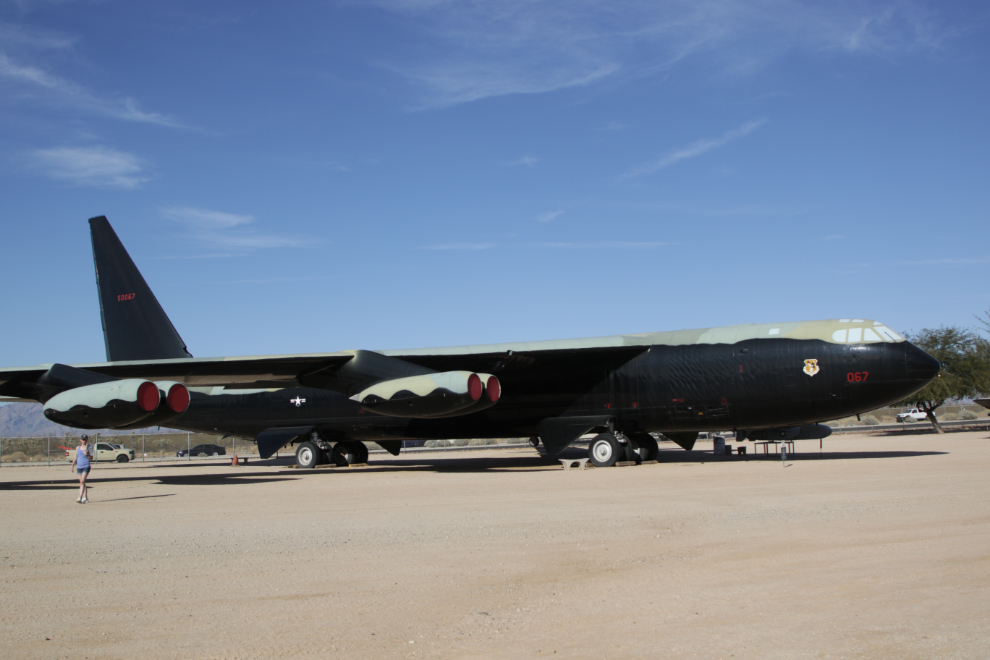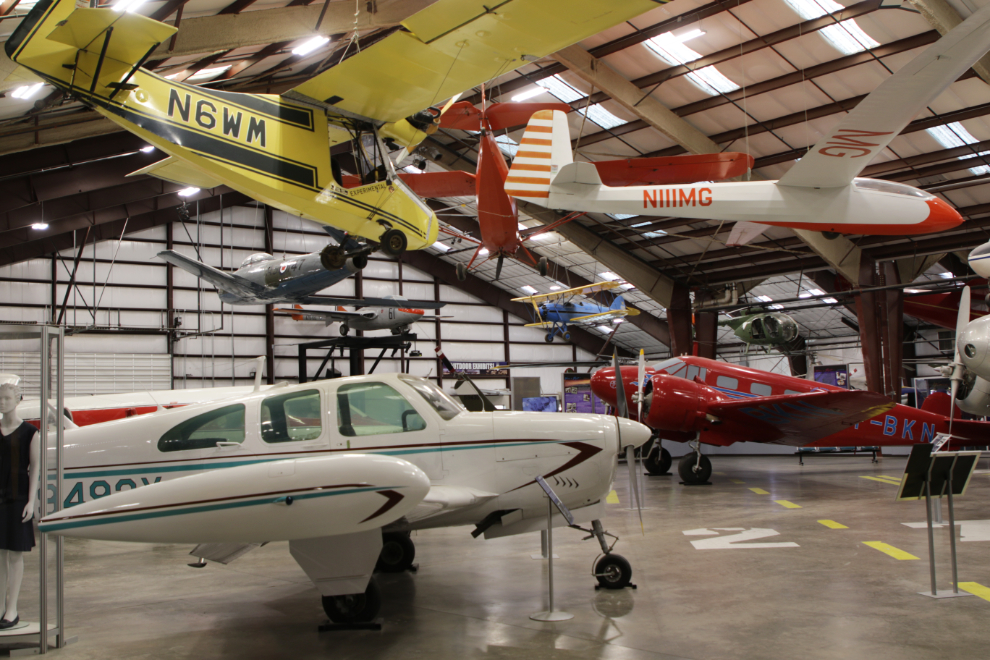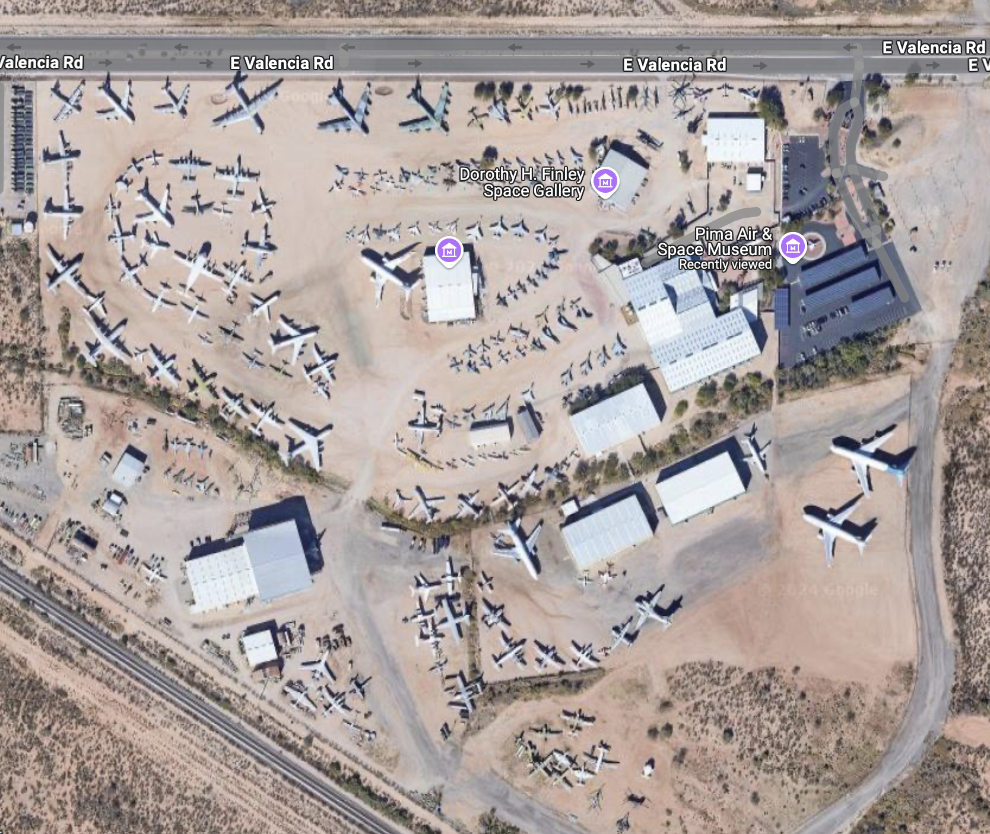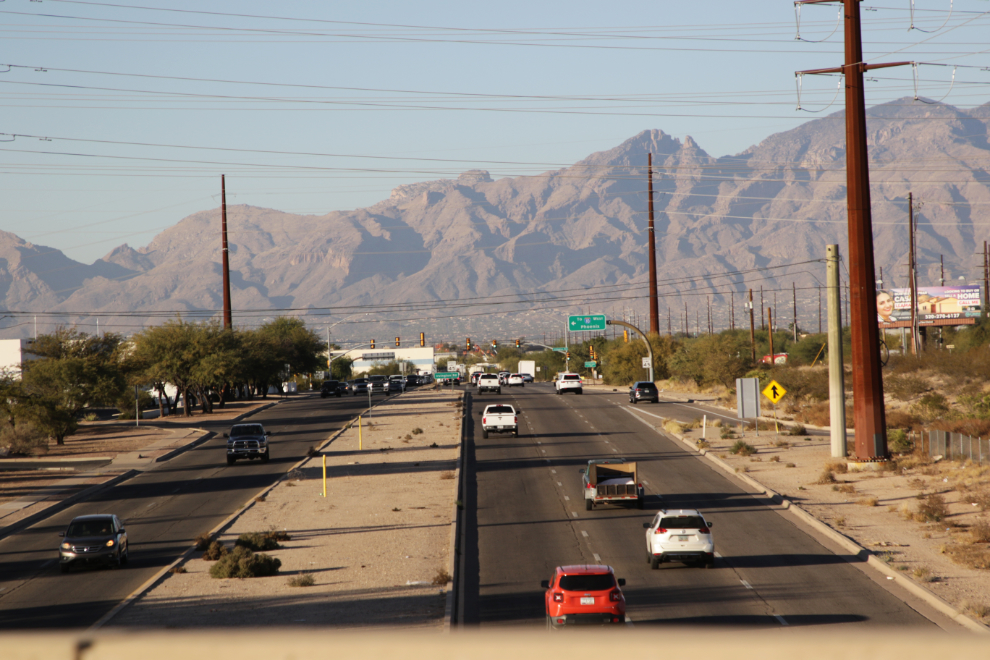A visit to the Pima Air & Space Museum in Tucson
The Pima Air & Space Museum is one of the largest non-government funded aviation and space museums in the world, with over 400 aircraft spread over 80 acres, with six large hangars. They recommend 3-4 hours for a visit, but after 2 hours and 160 photos I was totally exhausted and had to leave. The 3-hour tour at the Desert Museum had certainly set me up for that sort of failure and wasn’t unexpected, and it was still an excellent 5-star visit – next time I’ll get a 2-day pass.
Over half the parking spots are under roofs which are covered with solar panels. We were greeted outside the entrance by a Douglas A-4C Skyhawk. This is the first version of the Skyhawk to be capable of all-weather and night operations, and 638 were built between 1959 and the end of 1962. This particular aircraft was used by Flight Systems Inc. to test equipment between 1974 and 1981, with the civilian registration N401FS, licensed as “Experimental.” The desert sun is very hard on paint, and the original vibrant blue has badly faded – that is the reality of all the outdoor aircraft.

The entrance. Admission cost $22.50 for Andrea and $19.75 for me. A 2-day pass only costs $6 more for each.

Wow, what a great Welcome!!

Whatever your aviation interest (without even getting to the Space side!), Pima has something of interest – military or civilian, jet, propeller, rotary or glider). The Starr Bumble Bee was built in 1984 for the sole purpose of taking the record as the smallest aircraft. It has a wingspan of 6 feet 6 inches and could hit 180 mph, but only held the record for a few months.

A Curtiss F6C-4 Hawk powered by a Pratt & Whitney R-1340 radial. Built in 1931, This one has the markings of Marine Fighting Squadron Ten, San Diego.

Only a handful of these 2-passenger helicopters were built starting in 1953. Designed by the Helicopter Engineering Research Corporation in 1948, it was the McCulloch Motors Corporation that built it, as the HUM-1.

The huge McDonnell Douglas F-4E Phantom II flew for the Thunderbirds Aerial Demonstration Team from 1969 to 1973.

The de Havilland T.35 Vampire jet fighter was designed for the Royal Air Force, and the first prototype flew in September 1943. This particular aircraft was built in Australia for the Royal Australian Air Force, which had nearly 200 in service from 1952 until 1970.

Production of the Mikoyan-Gurevich MiG-29 Fulcrum-A began in 1982. This aircraft was assigned to the 86th Guards Fighter Aviation Regiment in Moldavia – in 1997 the United States purchased 21 of these Moldavian aircraft in order to prevent the nuclear-capable aircraft from being sold to potentially unfriendly nations.

This is only part of the impressive helicopter collection outside.

The Sikorsky H-5G Dragonfly was used primarily for search and rescue missions, from 1943 until 1960.

The “evil eyes” are on a Boeing Vertol CH-46E Sea Knight transport helicopter That served with Marine Helicopter Squadron HMM-163.

This wild Beechcraft UC-45 Expeditor (the military version of the Beech 18), was part of a 2012 art project called “Naughty Angels.”

The impressive Convair B-58 Hustler, which entered service in March 1960, was the first operational bomber capable of Mach 2 flight. A total of 116 were built, but due to several significant problems was only in operation for ten years.

This is a Martin B-57E Canberra in the 1970 markings of the 363rd Tactical Reconnaissance Wing, Shaw AFB, South Carolina. It was brought the the US specifically for towing aerial targets, but could be converted to a bomber, and some were to replace combat loses in Vietnam. In July 1967, a USAF Canberra listed as a fighter-bomber crashed at Whitehorse while attempting to land for refuelling – both crew members were killed.

I stitched two 24mm photos together to get this massive (it weighed 488,000 lbs loaded!) Boeing B-52G Stratofortress in one image. The “G” variant was introduced in 1958. This aircraft has the January 1991 markings of the 2nd Bombardment Wing, 596th Bomb Squadron, Barksdale AFB, Louisiana.

The fourth model of the B-52, the B-52D, was the second most produced version of the Stratofortress. Delivery of the “D” models began in 1956 and a total of 170 were built.

The Convair B-36J Peacemaker was the largest bomber and the last piston-engine-powered bomber produced by the United States. It has a wingspan of 230 feet and is 162 feet, 1 inch long. First designed to meet a World War II requirement for a plane capable of hitting targets in Germany from bases in the United States, the prototype did not fly until August 8, 1946, but a total of 383 Peacemakers were built between 1947 and 1954.

This is a Boeing EB-47E Stratojet. The B-47 was the first all-jet bomber produced anywhere in the world, and over 2,000 were built between 1947 and 1957. During the early 1960s, a number of B-47E models were converted for use as electronic intelligence-gathering aircraft (thuis being designated EB-47E). Additional antennas were mounted on the aircraft and a capsule was installed in the aircraft’s bomb bay that carried additional equipment to monitor radar and radio signals. The cart going by is a tour that’s offered.

This is an Avro Shackleton AEW.2. She was built in 1953, as a Shackleton MR.2, then was quickly converted to a Shackleton AEW.2 when taken on strength by the Royal Air Force as WL790. She was ferried from the UK to the USA in 1994 and given the registration N790WL.

The Fairey Gannet sure wouldn’t win any beauty contest, but in anti-submarine warfare operations it was hard to beat. Developed for the Royal Navy, it went into service in 1954, and served for many countries around the world. It has folding wings for carrier use, and was propelled by two contra-rotating propellers.

Another aircraft taking up a whole lot of real estate is this Boeing KB-50 J Superfortress aerial tanker. In this aircraft, two J-47 turbojet engines have replaced the outboard external fuel tanks so it could keep up with faster fighter jets in use. A total of 370 B-50s were produced starting in 1947.

This Fairchild C-123B Provider was operated by the US Coast Guard from 1960 until 1972. The design was originally developed in 1949 by Chase Aircraft as a cargo glider that could be converted to power.

For someone like me, a view like this is both exciting and intimidating. Intimidating because there’s a whole lot of information to gather and process in a short time period.

In the late 1950s the US Air Force determined that there was a need for a new aircraft to support the DEW Line early-warning radar sites located across northern Alaska and Canada. Testing proved that the C-130 could be easily adapted to this job, and twelve ski-equipped C-130Ds were built in 1958. More were later converted for use in Antarctica.


The Sikorsky S-43 “Baby Clipper” and its military cousin, the JRS-1, were designed in the late 1930s as airliners and military personnel transports. Fifty-three were built between 1937 and 1941 for civilian customers and the U.S. Navy. Although this particular aircraft is an civil S-43, it has been painted in the U. S. Marine Corps markings of VMJ-2. The name “Baby Clipper” came from its use by Pan American Airlines on shorter routes for which the larger flying boats were not needed.

A Cessna 120 sits in front of Trans World Airline’s Lockheed C-69 Constellation “Star of Switzerland.” Its livery is TWA’s 1950 design.

Northrop YC-125A Raider XB-GEY, powered by three Wright R-1820-99 Cyclone engines, was built in 1948. This aircraft was used by the USAF as a 30-seat troop carrier.

The Grumman OV-1 Mohawk was an armed military observation and attack aircraft designed for battlefield surveillance and light strike capabilities, able to operate from short, unimproved runways. Although hidden by the tree, it has a triple tail. A total of 380 were built between 1959 and 1970.

I was tiring quickly so we headed inside for at least part of another hangar tour. The star of this hangar is Consolidated B-24J Liberator “Bungay Buckaroo.” This aircraft flew coastal patrol missions with the Indian Air Force into the 1960s, and was donated to the museum by the Indian government. A total of 18,493 B-24s were built, 6,678 of them the very successful “J” model.

It would take at least an hour just to properly go through the artifacts in display cases.

Luckily I spotted a TG-6 glider overhead. In June 1942 the asked Aeronca, Piper, and Taylorcraft if they could build a glider that would act like a “dead-stick” powered aircraft – the TG-6 was the result, and each manufacturer was contracted to build 300 of them, though that total was never reached. This is the only known survivor.

This display shows an unmanned Fieseler FI103-A1 (V-1) Hoellenhund “buzz bomb” being readied to launch in Germany in 1944. Eventually, more than 5,800 of the missiles would land in England, killing over 8,000 people.

I didn’t note what this giant seaplane is.

Here are a couple of photos of the many aircraft in that hangar I didn’t get to.


One more photo before we left – me and Amelia 🙂 Yes, she probably could have convinced me to go on that final flight instead of Frank Noonan…

Here’s an aerial photo of the museum property. What an incredible, priceless collection. I am so lucky to have finally seen some of it.

Leaving the museum grounds. Now we had about 120 miles to drive to Phoenix. Well, Andrea had about 120 miles to drive. I slept for part of it, I expect.

Passing through Tucson.


An awesome peak somewhere north 🙂

After making a poor choice for our first night’s accommodation in Phoenix, I changed our final night to the Marriott! That didn’t work either. The room (#317) was wonderful, of course, but every public space in the hotel had been taken over by four busloads of very large and very loud football players. The staff was stressed out, there was no place for a quiet evening drink, and no nice place for dinner. We drove to a nearby joint for chicken fingers…

On Saturday, Day 9 of my trip, we just had to fuel up and drop the car off before our noon flights to Seattle and Calgary.
